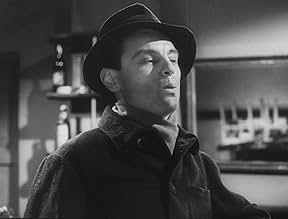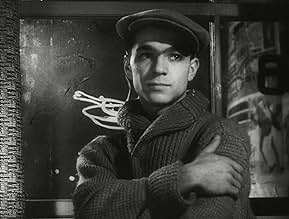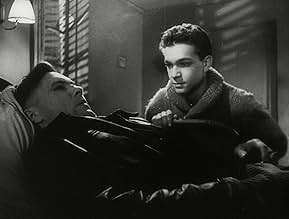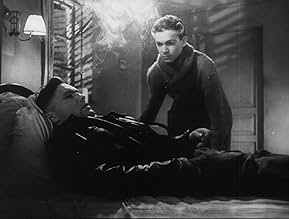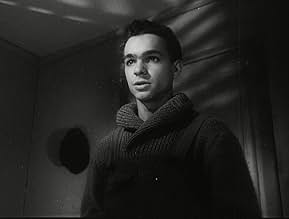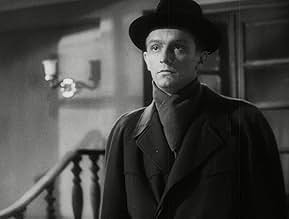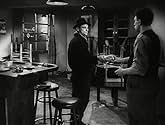IMDb RATING
6.5/10
3.9K
YOUR RATING
Two men besiege a lunch bar looking for a third man they must kill.Two men besiege a lunch bar looking for a third man they must kill.Two men besiege a lunch bar looking for a third man they must kill.
- Directors
- Writers
- Stars
- Directors
- Writers
- All cast & crew
- Production, box office & more at IMDbPro
Featured reviews
This film is interesting for being what it is--a Soviet cinema school's student project depicting a Hemingway short story--one of the student performers being Andrei Tarkovsky. As a film on its own right, its acting and direction are uneven. That said, I thought some of the acting was fine. The mood is a bit too subdued and less menacing than the story as I remember it. Then again, the cast were all close to 20--so that's probably is to be expected. According to most accounts, this was the first project from the Soviet film school portraying a non Russian story--and this choice, which was freshly published at the time was chosen by the young Tarkovsky himself, 4.5 stars out of 10
For a class project in a cinema program this isn't bad at all, more of a reenactment of Hemingways's killer short story than a feature film. It takes about as long to watch it as it does to read the original story, with which I assume most of us are familiar.
The images are rather crude, the sets spare, and some of the acting is amateurish, although Aleksandr Gordon as George, the manager, is pretty good. He has the pock-marked sullen face that seems suitable to the role of the ordinary man in a frightening one-down position. The other notable performance is by Vasili Shukshin as Ole Anderson, the resigned victim awaiting his fate in a dumpy rooming house.
The movie follows the written story closely. In print, when Ole is visited by Nick Adams and, halfway through the conversation, rolls over and faces the wall, he does the same on film. We don't see much of Ole's room. I suppose the budget didn't allow for much display. But when Ole stubs out his cigarette on the wall next to his bed, we see that numerous other butts have been stubbed out in the same place and that tells us most of what we need to know.
The directors have made a few changes that don't interfere with the narrative in any way -- bits of business in which one of the killers flicks a few tiny objects off the counter top with his fingertip, that sort of thing.
The only jarring change is the virtual elimination of the role of Sam the black cook. It's too bad because this is in no way a funny story and Sam provides the few light-hearted moments.
No sign of directorial self display. It opens with a POV shot and there are one or two other slight surprises but it's not a Fourth of July fireworks by any means. It's functionally presented.
The English names of the characters is retained and on the café window we see that coffee costs "5 centes." I call it admirable fealty to the source, mistake and all.
What must it have been like, living in a nation in which Ernest Hemingway's work wasn't allowed to be published until 1956? But never mind literature -- can you imagine American movies without ten versions of "Crime and Punishment"? I'm waiting for a Hollywood blockbuster called "The Master and Margarita" starring Jude Law and Angelina Jolie.
The images are rather crude, the sets spare, and some of the acting is amateurish, although Aleksandr Gordon as George, the manager, is pretty good. He has the pock-marked sullen face that seems suitable to the role of the ordinary man in a frightening one-down position. The other notable performance is by Vasili Shukshin as Ole Anderson, the resigned victim awaiting his fate in a dumpy rooming house.
The movie follows the written story closely. In print, when Ole is visited by Nick Adams and, halfway through the conversation, rolls over and faces the wall, he does the same on film. We don't see much of Ole's room. I suppose the budget didn't allow for much display. But when Ole stubs out his cigarette on the wall next to his bed, we see that numerous other butts have been stubbed out in the same place and that tells us most of what we need to know.
The directors have made a few changes that don't interfere with the narrative in any way -- bits of business in which one of the killers flicks a few tiny objects off the counter top with his fingertip, that sort of thing.
The only jarring change is the virtual elimination of the role of Sam the black cook. It's too bad because this is in no way a funny story and Sam provides the few light-hearted moments.
No sign of directorial self display. It opens with a POV shot and there are one or two other slight surprises but it's not a Fourth of July fireworks by any means. It's functionally presented.
The English names of the characters is retained and on the café window we see that coffee costs "5 centes." I call it admirable fealty to the source, mistake and all.
What must it have been like, living in a nation in which Ernest Hemingway's work wasn't allowed to be published until 1956? But never mind literature -- can you imagine American movies without ten versions of "Crime and Punishment"? I'm waiting for a Hollywood blockbuster called "The Master and Margarita" starring Jude Law and Angelina Jolie.
What the hell is that "Carnival of Colors" on Douban, the director of the 1935 film was Tarkovsky, born in 1932.
Tarkovsky's real nominal debutante is a far cry from the other master's earlier film, The Killer, which seems to have set a different style from the start. But this Tarkovsky without his later that the style of the scene shaping, on the contrary, quite a kind of Hollywood in that era of student work. But the audio-visual does have some aura, especially the fat man on the bed part especially has the style of Tarkovsky's kind of subtle mature dialogues.
The ending and some of the shaping is subtle, but not in Tarkovsky's style. Very strange lag, feels like 16 fps.
Tarkovsky's real nominal debutante is a far cry from the other master's earlier film, The Killer, which seems to have set a different style from the start. But this Tarkovsky without his later that the style of the scene shaping, on the contrary, quite a kind of Hollywood in that era of student work. But the audio-visual does have some aura, especially the fat man on the bed part especially has the style of Tarkovsky's kind of subtle mature dialogues.
The ending and some of the shaping is subtle, but not in Tarkovsky's style. Very strange lag, feels like 16 fps.
I rather like Hemingway's short story which the film is an exact transcription of, but I didn't feel the same things here. In fact, I didn't feel anything. There is, in the way Hemingway's text begins, a playful opacity about who is who, which obviously cannot be found in the film form. Moreover, a large part of the value of the text lies in the laid back, direct, and popular side of the dialogues, difficult to appreciate here if you don't speak Russian, of course. Nothing impressed or bothered me in the filming itself, it's neutral. The acting is very average, but it's hard to expect anything else from a student film.
This is the best student film I have ever seen. Not only in directing but style also. It's black and white as every good film noir is. If you can call this short film noir or not though is up for discussion. This is a very faithful adaption of Ernest Hemingway's short story The Killers. And the way it's shot, cut and acted is truly remarkable. Especially in one scene when a man walks into the diner while the killers have Nick Adams and the cook tied up in the back. The whole scene plays out without any dialogue but with the customer whistling a happy tune while George makes him his sandwich. A very good scene.
The short has no soundtrack and doesn't need one either. With the situation and the dialogue it all speaks for itself. A very good short and worth the money I payed for it.
The short has no soundtrack and doesn't need one either. With the situation and the dialogue it all speaks for itself. A very good short and worth the money I payed for it.
Did you know
- TriviaAll the roles were played by students of the VGIK. Moreover, props were not only brought by students from their homes, but also provided from friends and relatives.
- ConnectionsFeatured in Une journée d'Andrei Arsenevitch (1987)
- SoundtracksLullaby of Birdland
Written by George Shearing
(1952)
Whistled by the second bar patron played by Andrei Tarkovsky
Details
- Runtime
- 19m
- Color
- Sound mix
- Aspect ratio
- 1.37 : 1
Contribute to this page
Suggest an edit or add missing content

